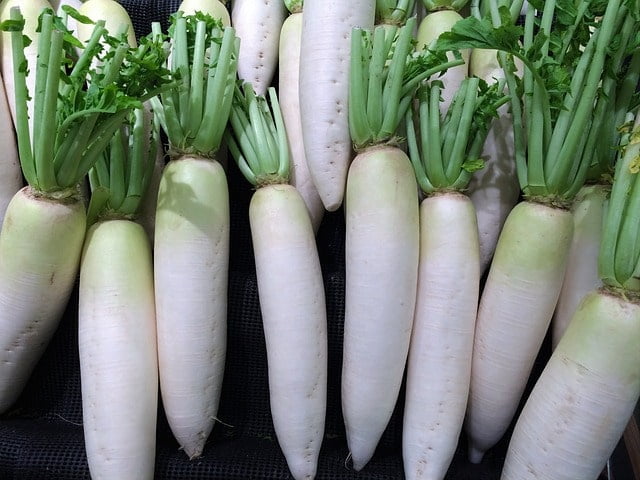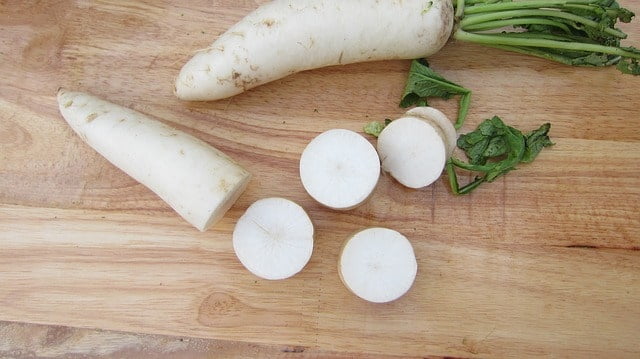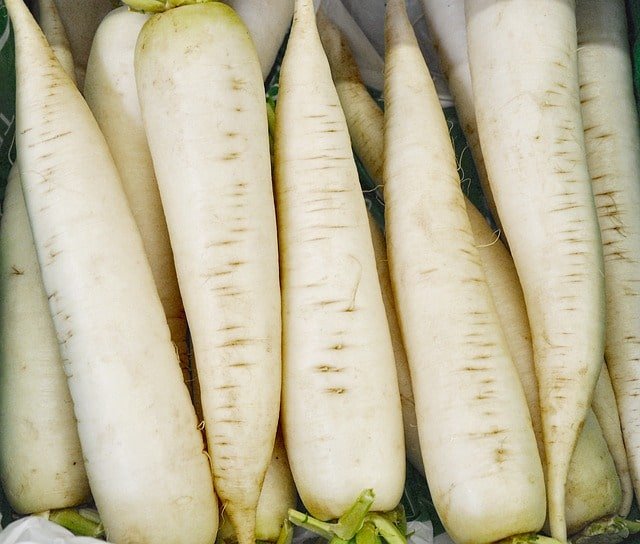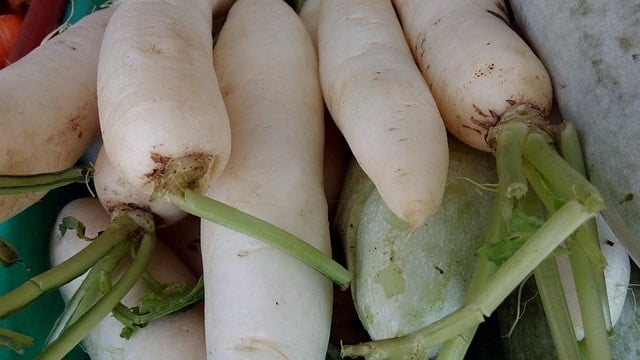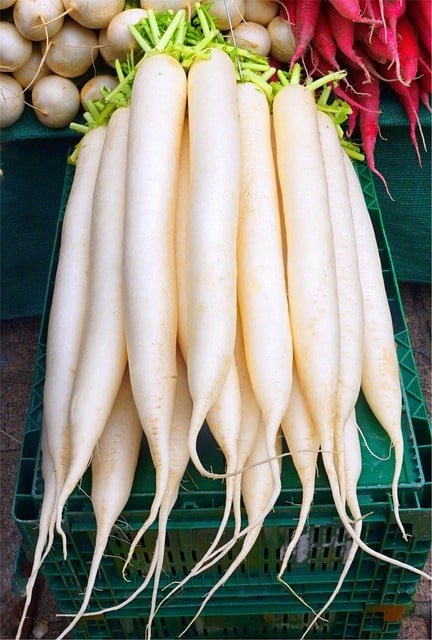What is Radish (Mooli or Muli)?
Radish (Mooli or Muli), also known by the scientific name Raphanus sativus, is a root vegetable that belongs to the Brassicaceae family. It is a member of the cruciferous vegetable family and, like other members of this family, produces distinctive oil which gives it its pungent flavor.
Radishes come in many distinct types throughout the world. Daikon White Radish, Pink Radish, Watermelon Radish, Zlata Radish, and others vary in size, weight, and color. Radishes have a variety of uses and can be eaten raw, roasted, pickled, or even drunk as radish juice.
Radishes have an array of minerals, vitamins, and nutritional compounds that can positively boost your health. These have many health benefits from aiding in digestion to protecting the heart.
What is the Nutrition Value (Facts) of Radish (Mooli) Vegetable?
Radishes are high in nutrients and vitamins and can help you achieve a variety of health goals if you include them in your diet.
Radishes are extremely low in calories and cholesterol-free. They’ve got a good amount of fiber and protein in them.
Radishes are also rich in Vitamin C, which is necessary for body immunity as well as a variety of other functions.
Minerals such as potassium, calcium, iron, and manganese are found in abundance in radish.
The Nutrition Value (Facts) of Radish (or Muli or Mooli) is as under:
| Nutritional Value per 100 gram serving of Radish (Mooli), raw (1) | |
| Energy | 16 Kcal |
| Water | 95.3 g |
| Carbohydrates | 3.4 g |
| Sugars | 1.86 g |
| Dietary fiber | 1.6 g |
| Protein | 0.68 g |
| Fat | 0.1 g |
| Minerals | |
| Sodium | 39 mg |
| Calcium | 25 mg |
| Potassium | 233 mg |
| Copper | 0.05 mg |
| Iron | 0.34 mg |
| Magnesium | 10 mg |
| Phosphorus | 20 mg |
| Zinc | 0.28 mg |
| Selenium | 0.6 mcg |
| Vitamins | |
| Vitamin B1 (Thiamine) | 0.012 mg |
| Vitamin B2 (Riboflavin) | 0.039 mg |
| Vitamin B3 (Niacin) | 0.254 mg |
| Vitamin B6 | 0.071 mg |
| Folate | 25 mcg |
| Vitamin C | 14.8 mg |
| Vitamin K | 1.3 mcg |
What are the Uses and Health Benefits of Radish Vegetables (Mooli)?
The best uses and health benefits of Radish are listed here. There are several types of radish each with its own set of uses and health benefits.
I’ll explain to you the 14 uses and health benefits of radish in this article. These are:
1) Benefits of Radish (Mooli) in Jaundice
Radish (with its leaves being the most effective) is commonly used as a natural treatment for jaundice. Its juice is also beneficial in jaundice as it has a strong detoxifying effect, which helps in the elimination of toxins from the blood and thus assists in the purification of the blood.
By aiding in the removal of bilirubin and also by regulating its production this vegetable is helpful in the treatment of jaundice. By improving the flow of oxygen in jaundice patients, radish is also helpful in the prevention of the destruction of RBCs (red blood cells).
2) Radish (Mooli) Benefits for Arthritis
Vitamin C, which is plentiful in radish, helps your body to fight free radicals and protects body cartilage. This vitamin is also helpful in the formation of collagen, and this is the substance that makes up our body’s cartilages.
The sulforaphane present in radish (a cruciferous vegetable), can be beneficial for osteoarthritis (10). This compound works by inhibiting cartilage destruction in cells.
Hence, consuming this vegetable is helpful in the prevention of diseases like arthritis.
3) Radish May Lower Cancer Risk
Because of the presence of powerful antioxidants including folic acid, vitamin C, and anthocyanins; radishes help in the prevention of cancers like oral, stomach, colon, intestinal, and kidney cancers.
Radishes are cruciferous vegetables, and these vegetables have compounds that when combined with water are broken down into isothiocyanates (2). These isothiocyanates may cause apoptosis (or cell death), in cancer cells by disturbing their genetic pathways. This prevents cancer cells from proliferating.
A study conducted in 2010 found that radish root extract has several types of isothiocyanates that resulted in cell death in some cancer cell lines (3).
In the case of breast-cancer radish was also found to display chemopreventive effects. This vegetable could directly obstruct the growth of cancer cells and induce cancer cell death. Thus, it can be useful for cancer treatment and prevention (4).
4) It May Promote Digestive Health
Fiber helps to prevent constipation by adding bulk to your stool and helping waste move through your intestines. Radish is high in dietary fiber and may promote your digestive health.
Its leaves may also be beneficial. A study conducted in 2008 on rats fed a high-cholesterol diet showed that radish leaves are a good source of fiber and help to improve digestion. Increased bile production may also be one of the reasons (8).
This vegetable has been used ethnically as a digestive aid, laxative, stimulant, and treatment for stomach disorders (9).
5) Radish (Mooli) benefits in Urinary Tract System
Radishes have a diuretic effect, which means they assist to cleanse the kidneys by increasing urine production. Its juice is helpful in treating inflammation and lessening the burning sensation that is experienced by some people while urinating.
Consuming this vegetable stimulates urine output, which helps to avoid infections in the urinary system and other kidney diseases.
6) Radish (Mooli) Benefits for Heart Health
Radishes contain anti-inflammatory anthocyanins that help in the prevention of cardiovascular disorders. They also help in preventing other side effects like heart failure, and peripheral artery disease.
Anthocyanins also help in the circulation of metabolites and prevent cardiovascular diseases by lowering inflammation and oxidative stress.
Studies conducted on rats have shown that extracts of radishes influence nitric oxide production. This causes a reduction in blood pressure by relaxing the blood vessels (5).
Nitric oxide also helps to relax smooth muscle tissue and increases the regional blood flow. It also checks platelet adhesion to the blood vessel walls. Hence, with all these benefits nitric oxide lowers the risk of atherosclerosis (6).
7) Radish (Mooli) Benefits for Immune System
The Vitamin C content in radish makes it an ideal choice for improving your body’s immunity. Vitamin C is helpful in the synthesis of collagen and regulates body metabolism. This collagen assists in the strengthening of blood vessel walls and the prevention of cardiovascular illnesses.
8) It Helps In Reducing Weight
If you’re trying to lose weight, radishes are a good choice because they’re low in calories, rich in fiber, and high in water.
The high fiber content in this vegetable makes you feel fuller and helps you avoid overeating. This will help you in losing weight
9) Radish (Mooli) May Lower Blood Pressure
Radish is a rich source of potassium, which acts as a vasodilator, allowing blood vessels to relax and helping the blood to flow more freely. This can help lower your blood pressure, and keep your blood flow in control, particularly if you are suffering from high blood pressure (hypertension).
10) It May Help To Control Diabetes
Because of a low glycemic index, radish has an anti-diabetic effect and doesn’t cause your blood sugar levels to rise rapidly.
It also enhances the antioxidant defense mechanism and reduces the accumulation of free radicals in the body. This encourages energy metabolism and lowers glucose absorption in the intestine, thus aiding individuals with diabetes (7).
11) Has Antifungal properties
Radish is a natural antifungal. It has the antifungal protein RsAFP2. One study has shown that RsAFP2 caused cell death in Candida albicans, which is a common fungus normally found in humans (11). And when Candida albicans overgrows, it may cause oral yeast infections (thrush), vaginal yeast infections, and invasive candidiasis.
One earlier study conducted on mice has also shown that apart from Candida albicans, RsAFP2 was also effective against other Candida species to a lesser degree. It was not effective against Candida glabrata strains (12).
12) Benefits of Radish (Mooli) in Lung Problems
This vegetable has anti-congestive characteristics that are helpful in preventing the irritation of the throat, nose, windpipe, and lungs. Common colds, allergies, infections, etc. are the most common causes of these irritations. Radishes, being rich in vitamins and minerals, can act as disinfectants and help in protecting the respiratory system from infections.
13) Benefits of Radish (Mooli) for Skin
The presence of vitamin B-complex, vitamin C, phosphorus, and zinc in radish makes it beneficial for your skin. The high water content of this vegetable aids in skin hydration.
This vegetable has disinfectant properties that help in preventing skin ailments such as rashes, dry skin, and cracks.
Radish root and its juice are often used for skincare. Dry skin and cracks can be treated with a mixture of its juice and olive oil.
Raw radish, when mashed, functions as a natural cleanser and face pack.
14) Benefits of Radish (Mooli) for Hair
Your hair must be strong, just like your face must be attractive to others. Hair loss can be alleviated by drinking radish juice.
When rubbed into the scalp juice of the radish helps to treat hair fall and dandruff. Leave its juice on the hair for about 15 to 20 minutes after massaging it in. Following that, shampoo your hair completely. Because its juice strengthens your hair roots, doing this twice a week minimizes hair loss.
Always try to use its fresh juice for the best results. Hair gets stronger and more lustrous as a result of this process. It will also help in improving the overall texture and health of your hair.
What are the Side Effects of Radish (Mooli)?
Anything ingested in excess is harmful to your health. There are no negative effects from eating radish in moderation.
Possible 7 radish-related adverse effects or side effects are:
1) Upset Stomach
Consumption of radish is generally safe. But consuming it in large amounts can irritate your digestive tract and cause flatulence and cramps.
2) Radish (Mooli) May Cause Hypoglycemia
Radish can lower blood sugar levels due to its hypoglycemic effects (7). Those who are already on anti-diabetic medications may need to consult with their doctor before consuming this vegetable, as eating it in large amounts may cause hypoglycemia (lower blood sugar levels).
3) Radish during Pregnancy and Breastfeeding
There is not much evidence to support that radish is safe to use for pregnant or breastfeeding women. It is safer to consume this vegetable in moderate amounts. But it’s better to consult your doctor before you consume.
4) It May Aggravate Hypothyroidism
Cruciferous vegetables, such as radish, contain goitrogenic substances that may interfere with the formation of the thyroid hormone in the body. Studies have found that chronic radish feeding can lead to lowered thyroid hormone profiles (13).
Thus, people having thyroid issues (mainly hypothyroidism) should limit their consumption of radishes.
5) It May Increase Risk of Gallstones
Bile secretion is increased by radish consumption (14). Some researchers believe that this property may increase the risk of gallstones in vulnerable individuals. Also, because gallstones clog the bile duct, patients with gallstones may experience acute pain after eating this vegetable. Although more research is required, it is essential to take precautions.
6) Avoid Before Surgery
Avoid eating large amounts of radish two weeks before your surgery because of the influence it has on your blood sugar level. This will help you avoid any issues during and after your procedure
7) Risk of Dehydration
Radish is largely made up of water and has characteristics that cause a lot of peeing. As a result of the significant water loss caused by frequent urination, you may get dehydrated.
Final Word
Radishes are high in nutrients and low in calories. These are well known for their spicy pungent taste. These may help in the treatment of jaundice, and several gastrointestinal disorders, may promote heart health, and boost the immune system.
They are an underappreciated superfood that can help you avoid serious ailments and possibly slow down the aging process.
Radishes are a great complement to your diet when consumed in moderate amounts. However, its excess intake can cause some side effects too.
I hope that this article has helped you learn more about the health advantages of radishes. On the other hand, I hope you will think about the potential health risks of eating radish before eating them in large amounts.
Frequently Asked Questions
Can you eat radish tops?
Yes, you can eat.
Because its tops or its leaves are nutritious, delicious, and edible. One simple way to eat them is by adding them to your cooking preparations.
Who cannot eat radish?
Patients having gallbladder, and thyroid-related problems should avoid radishes. If they want to eat this vegetable then it is better to consult a doctor before eating.
Are radishes good for hair growth?
Because of the high concentration of nutrients present in this vegetable, it may be beneficial for hair growth.
————————————————
References:
1) U.S. DEPARTMENT OF AGRICULTURE, FoodData Central
https://fdc.nal.usda.gov/fdc-app.html#/food-details/1103374/nutrients
2) Deciphering the Nutraceutical Potential of Raphanus sativus-A Comprehensive Overview
https://pubmed.ncbi.nlm.nih.gov/30769862/
3) Hexane Extract of Raphanus sativus L. Roots Inhibits Cell Proliferation and Induces Apoptosis in Human Cancer Cells by Modulating Genes Related to Apoptotic Pathway
https://link.springer.com/article/10.1007/s11130-010-0178-0
4) Radish (Raphanus sativus L. leaf) ethanol extract inhibits protein and mRNA expression of ErbB2 and ErbB3 in MDA-MB-231 human breast cancer cells
https://www.ncbi.nlm.nih.gov/labs/pmc/articles/PMC3180678/
5) The antihypertensive effect of ethyl acetate extract of radish leaves in spontaneously hypertensive rats
https://www.ncbi.nlm.nih.gov/labs/pmc/articles/PMC3439574/
6) Cardiovascular Health Benefits of Specific Vegetable Types: A Narrative Review
https://www.ncbi.nlm.nih.gov/labs/pmc/articles/PMC5986475/
7) Radish (Raphanus sativus) and Diabetes
https://www.ncbi.nlm.nih.gov/labs/pmc/articles/PMC5622774/
8) Effect of Radish Leaves Powder on the Gastrointestinal Function and Fecal Triglyceride, and Sterol Excretion in Rats Fed a Hypercholesterolemic Diet
https://agris.fao.org/agris-search/search.do?recordID=KR2009001541
9) Effects of White Radish (Raphanus sativus) Enzyme Extract on Hepatotoxicity
https://www.ncbi.nlm.nih.gov/labs/pmc/articles/PMC3834419/
10) Isothiocyanates are detected in human synovial fluid following broccoli consumption and can affect the tissues of the knee joint
https://www.ncbi.nlm.nih.gov/labs/pmc/articles/PMC5469854/
11) The plant defensin RsAFP2 induces cell wall stress, septin mislocalization, and accumulation of ceramides in Candida albicans
https://onlinelibrary.wiley.com/doi/full/10.1111/j.1365-2958.2012.08017.x
12) In Vitro Activity of the Antifungal Plant Defensin RsAFP2 against Candida Isolates and Its In Vivo Efficacy in Prophylactic Murine Models of Candidiasis
https://journals.asm.org/doi/full/10.1128/aac.00448-08
13) Effect of radish (Raphanus sativus Linn.) on thyroid status under conditions of varying iodine intake in rats
https://pubmed.ncbi.nlm.nih.gov/16924836/
14) Raphanus sativus L. var niger as a source of Phytochemicals for the Prevention of Cholesterol Gallstones
https://onlinelibrary.wiley.com/doi/abs/10.1002/ptr.4964
————————————————
Disclaimer: This article is intended for informational purposes only. Any information associated with this article should not be considered as a substitute for prescriptions suggested by local health care professionals.
————————————————
Recommended Articles:
1) Beetroot (Beets): Uses, Health Benefits, & Side Effects
2) Turnips (Shalgam): Uses, Health Benefits, & Side Effects
3) Broccoli: Uses, Health Benefits, Nutrition, Side Effects
4) Carrots: Uses, Health Benefits, Nutrition, & Side Effects
————————————————
